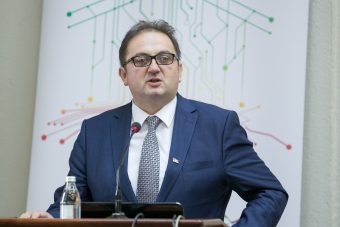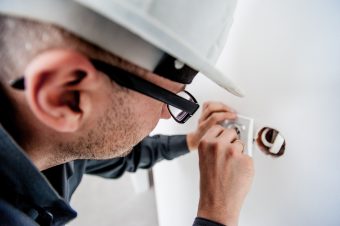
When we read the news in the field of energy, often we stumble upon terms such as feed-in tariff, auction, net metering and prosumer. If you are not familiar with them and they make you stop reading the article for a second, you will get a first-hand explanation. Professor Stevica Dedjanski, Ph.D., state secretary in the Ministry of Mining and Energy, has clarified these linguistic dilemmas to us. He explained that biomass is energy source beneficial to both nature and society due to producing green energy and reducing harmful emissions while creating green jobs. We also learned from him how to reduce our electricity bills by investing only a little money or no money at all.
EP: Was the adoption of the Law on Efficient Use of Energy in 2013 a turning point for more efficient use of energy compared to the previous practice?
Stevica Dedjanski: Its adoption has brought a systematical approach to the field of energy efficiency in the Republic of Serbia and has given a legal framework for transposing European regulations in that field. Until then, ad hoc activities were regulated by law. That is how the energy management for large energy consumers and the public sector has been introduced by law and how the budget fund for improving energy efficiency has been established. Besides that, labeling of energy efficient devices has been introduced; new companies have been recognized – ESCO companies that are financing energy-efficient projects on the basis of realized energy savings. For the first time, criteria of energy efficiency that should be included in the requests for public procurement of products have been clearly defined. Also, obligations in the drafting and implementation of the Energy Efficiency Action Plans resulting from the assumed obligations towards the Energy Community have been defined and methodological approach to determining savings has been adopted.
Energy savings are planned, implemented and recorded according to the national action plans for energy efficiency. According to the latest action plan from 2016, Serbia has achieved more than 90 per cent of savings planned for the period from 2010 to 2015, and almost 50 per cent of all the savings planned for the period from 2010 to 2018.
The law introduces the obligation to save one per cent of primary energy in the current year in comparison with the previous year to the system’s associates in the industrial sector and the public commercial sector.
EP: System of energy management has started functioning in 2017. How?
Stevica Dedjanski: According to the Law on Efficient Use of Energy, the system of energy management represents a system of organized energy management. The system’s associates accomplish the legally prescribed obligations to achieve rational energy use with as little cost as possible.
According to the law, the system’s associates include the enterprises and public companies that use more energy per year than government has prescribed; local self-government units with more than 20 thousands of residents; state administration bodies; other bodies of the Republic of Serbia; the bodies of the autonomous province; and public institutions. They create a program and a plan of energy efficiency for the sake of the achievement of the savings goals prescribed by the government; designate the needed number of energy managers; implement measure ment for the efficient energy use; submit an annual report on accomplishing the energy-saving goals; provide regular implementation of energy audits; perform other duties. The Ministry of Mining and Energy has so far identified more than 70 legal entities in the manufacturing sector, such as enterprises and public companies, as well as nine enterprises in the commerce and service sectors, and 79 local self-government units as the system’s associates.
In enterprises and public companies at the moment, there are 39 appointed energy managers with a license. A total of 45 local self-government units also have a licensed energy manager.

EP: How many energy managers are there in Serbia and has the system come into life practically speaking?
Stevica Dedjanski: Training of energy managers is carried out by the Faculty of Mechanical Engineering of the University of Belgrade for fields of industrial energy, energy at the municipal level and energy in the building sector. So far, 12 training rounds and 17 energy manager exams have been held. The Ministry has issued 103 licenses for the field of the municipal energy sector, 145 licenses for the field of industrial energy and 42 licenses for the field of energy in the building sector.
System associates continue to learn how to fulfill the legally prescribed obligations and how to achieve energy savings. For now, it is still too early to bring up good examples of energy management. The energy management system is well-conceived, but persistence and support in its implementation are needed.
EP: Although we legally made the first steps towards the improvement of energy efficiency, energy consumption per unit of GDP is about three times higher in our country than in the European Union. Is investing in energy efficiency measures out of the budget of our citizens, or is this a consequence of their insufficient knowledge of the money savings they would bring to them?
Stevica Dedjanski: According to the Statistical Office of the Republic of Serbia, the share of the household sector in the total final consumption is the highest. It amounts to 35 per cent, the economy 29 per cent, and transport 23 per cent. The analysis of buildings in Serbia has shown that 85 per cent of the building fund does not meet the minimum energy efficiency requirements. The prices of energy and energy will increase in the future, which will increase the cost of living.
Insufficient knowledge of the citizens about the possibilities and potential of energy efficiency, but certainly a limited budget as well, influence the state of energy efficiency in the household sector in our country.
In order to reduce energy consumption, it is necessary to operate in three aspects. In addition to making clear legal regulations and citizens’ awareness of the possibilities and potential of energy efficiency, we need a financial incentive in the form of incentive measures, subsidies and lower interest rates for investments in energy efficiency.

Even though we are behind some of the Western European countries in the fields of energy efficiency and renewable sources, we are heading in the right direction. In comparison to some European countries, we are at a similar level, or we are better. We are giving more and more importance to those fields in every segment of our society.
EP: PVC windows, air heat pump and wall and roof insulation, are some of the more expensive solutions for improving energy efficiency. Tell us several measures that do not require the investment of substantial funds.
Stevica Dedjanski: The cost-optimal energy rehabilitation of existing buildings, or the definition of a package of energy efficiency measures, is best determined by the characteristics and conditions for a concrete building, depending on its state. Those measures, which bring significant savings over time, are often, at the very beginning, a great investment.
However, there are also low-budget measures of energy efficiency such as replacing old bulbs with wire filaments with new LED lamps, installing sealing gums on exterior joinery, then installing curtains on windows and balconies located on the south and west side of the building due to too much sunshine in summer months, investing in energy efficient home appliances, installing thermostatic heads on radiators to optimize heat in rooms, etc.
Training.
Also, besides investment measures, reducing energy consumption is possible by applying measures that affect consumer behavior, for example: controlling if the household appliances are turned on or turned off (boiler, washing machine and oven should not be turned on at the same time), electricity and heating bills control, switching to paying the thermal energy per consumption which is profitable for isolated objects, and so on.
Prepared by: Jelena Kozbasic
Read the whole interview in the new issue of the Energy portal Magazine ENERGY EFFICIENCY.





